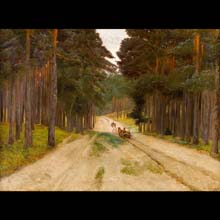
material: oil on canvas
dimensions: 59 × 81 cm
description: Chełmoński left Paris in 1887. Back in the country, he settled in Kuklówka near Łowicz. The artist’s escape from the hustle and bustle of the city life was accompanied by his deep spiritual transformation. Chełmoński developed a deep fascination with the native landscape, finding an emotional bond with nature. Painting from memory was replaced by detailed studies from nature. Working in the open air resulted in realistic landscapes showing Masovia, Polesie and Ukrainian motifs. Forest Track is an example of such works. One can see a forest track stretching from the foreground into the depths of the composition. The spatial character of the landscape has been emphasized with the slight unevenness of the terrain. The light-coloured surface of the track contrasts with the vertical rhythm of bare trunks topped with dark-green foliage. On the surface of the track one can see ruts cut by peasant carts, still visible in the distance. The work, painted quite meticulously, is rendered in muted colours. The simplicity of the motif, devoid of the picturesque, stresses the realism of the scene. The artist used this composition in a later, lost work entitled Forest Path. The motif of country or small-town paths as well as forest and field tracks played a major role in the iconographic repertoire of Polish Munich painters. Aleksandra Krypczyk
exposition: The Gallery of 19th Century Polish Art in Sukiennice,
The Cloth Hall, 1, Main Market Square
key: Realism, polish impressionism, beginnings of symbolism >>>
dimensions: 59 × 81 cm
description: Chełmoński left Paris in 1887. Back in the country, he settled in Kuklówka near Łowicz. The artist’s escape from the hustle and bustle of the city life was accompanied by his deep spiritual transformation. Chełmoński developed a deep fascination with the native landscape, finding an emotional bond with nature. Painting from memory was replaced by detailed studies from nature. Working in the open air resulted in realistic landscapes showing Masovia, Polesie and Ukrainian motifs. Forest Track is an example of such works. One can see a forest track stretching from the foreground into the depths of the composition. The spatial character of the landscape has been emphasized with the slight unevenness of the terrain. The light-coloured surface of the track contrasts with the vertical rhythm of bare trunks topped with dark-green foliage. On the surface of the track one can see ruts cut by peasant carts, still visible in the distance. The work, painted quite meticulously, is rendered in muted colours. The simplicity of the motif, devoid of the picturesque, stresses the realism of the scene. The artist used this composition in a later, lost work entitled Forest Path. The motif of country or small-town paths as well as forest and field tracks played a major role in the iconographic repertoire of Polish Munich painters. Aleksandra Krypczyk
exposition: The Gallery of 19th Century Polish Art in Sukiennice,
The Cloth Hall, 1, Main Market Square
key: Realism, polish impressionism, beginnings of symbolism >>>












